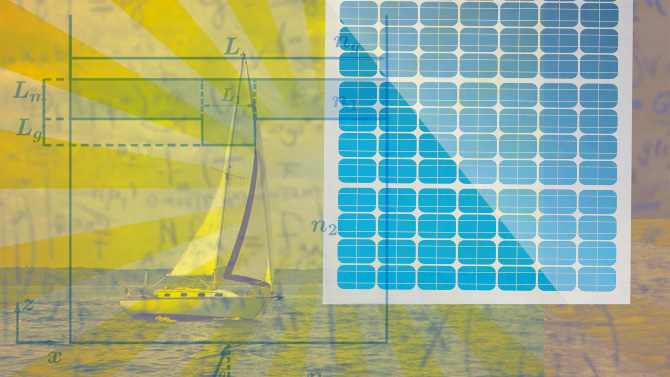


Grants support math research
Illustration by Jeffrey Chase August 01, 2016
Studies investigate topics from solar cells to water waves
The design of solar cells — which convert sunlight to electricity without using fossil fuels or producing greenhouse gases — is a kind of balancing act that aims to keep the cells’ many layers thin enough for cost-effective manufacturing but thick enough to absorb light and generate power.
A researcher at the University of Delaware is using mathematical modeling in search of an improved design that will produce thin but highly efficient solar cells.
“You need multiple layers of materials, each with a different function, to trap light across the spectrum,” says Peter Monk, Unidel Professor of Mathematical Sciences. “You want the cell to be as thin as possible, but then it also has to produce electricity.”
Monk and Akhlesh Lakhtakis, a professor of engineering science and mechanics at Pennsylvania State University, have received a three-year, $499,999 grant from the National Science Foundation (NSF) to study this problem of thin but efficient solar cells.
The two researchers worked together on a previous project, looking at light absorption in thin-film solar cells, and Monk said they found that using existing design codes didn’t yield the efficiency they had hoped to attain. As a result, they submitted their now-accepted proposal to the NSF to use computer modeling to develop new codes.
The researchers wrote that their team “will develop an integrated pair of computer models that simultaneously predict the absorption of sunlight and the consequent electrical performance of the solar cell using modern techniques from numerical analysis.”
The codes they develop will be made available to other photovoltaic researchers, they said.
More recent NSF grants awarded in mathematical sciences
The NSF has announced three other grants awarded to mathematics faculty members in a variety of research areas. Including Monk’s project, the awards total more than $850,000.
Following are the projects, with descriptions taken from the NSF award abstracts.
Rakesh Rakesh, professor of mathematical sciences, received a $151,542 grant to study the mathematics behind non-destructive testing — using sound waves, electrical currents and other noninvasive means to determine the properties of an object.
Such waves are used to study the interior of an object in fields ranging from medical imaging to oil and gas prospecting. The results of the research have the potential for important advances in imaging technology.
Qing Xiang, professor of mathematical sciences, was awarded a $70,846 grant to study algebraic methods in combinatorics and finite geometry.
Combinatorics, a fast-growing area of mathematics, studies discrete (or non-continuous) structures such as graphs and designs. It has applications in numerous scientific and engineering fields, including genome sequencing and cellular phone technology.
Philippe Guyenne, associate professor of mathematical sciences, received a $129,960 grant to study phenomena related to water waves, specifically the ways in which surface waves interact with internal waves and the ways they interact with rough topography.
The dynamics of coastal waves and strong currents can be hazardous to offshore and submerged structures and influence such processes as sandbar formation and beach erosion. The research has broader impacts in oceanography, marine biology, coastal engineering and climatology.
Contact Us
Have a UDaily story idea?
Contact us at ocm@udel.edu
Members of the press
Contact us at 302-831-NEWS or visit the Media Relations website

